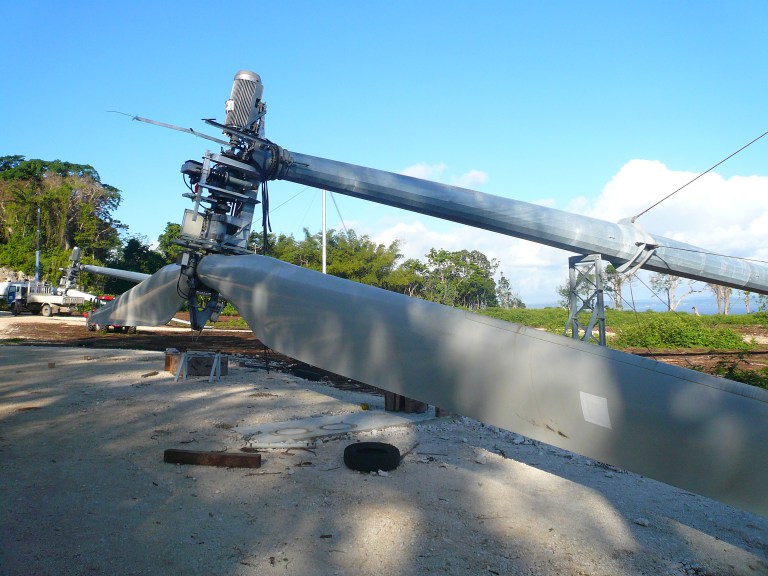How adaptation and mitigation bring together these important strands of the EIB’s work in small island states
Cyclone Pam was a catastrophe for Vanuatu. When the storm hit the South Pacific island republic last year, 320-kmh winds destroyed infrastructure, creating water shortages and shutting down telecommunications. Pam wiped out thousands of buildings, displaced 3300 people, and killed 16. For Vanuatu, the cost of rebuilding was devastating.
But one vital facility rode out the storm—thanks to a clean-energy company based near Orléans, a Paris-based conglomerate, and the EU bank. Engie’s Devil’s Point wind-farm folded over its ingenious turbines, developed by Vergnet Groupe and financed by the European Investment Bank, lashing them to the ground as Pam approached. Instead of surveying a devastated facility after the cyclone passed, the operators simply cranked the turbines back up and got on with the production of electricity.
Global warming threatens the very existence of small pacific islands due to rising sea levels. On top of that, extreme storms are becoming more frequent and are projected to grow in ferocity. Water infrastructure is easily put out of action by these storms, while tidal surges cause the salinization of groundwater, disrupting agriculture and potentially making small islands uninhabitable even before the sea overwhelms them.

Vanuatu de-mountable tilting mast wind turbine generator
Big finance for small islands
Projects like the Devil’s Point wind farm help islands mitigate their greenhouse-gas emission and adapt to the impact of extreme weather. By minimising the disruption to local economies such projects show that the fight against climate change is not just an environmental question. It is a development issue.
Overall the EIB is the world’s biggest climate-action financier, with EUR 20.7 billion of financing last year. Between 2011 and 2015 the EIB committed EUR 4.5 billion globally to projects that aim to adapt economies to the effects of climate change. The Bank is working to increase that investment and adopted a policy that makes adaptation a key element of climate projects.
Yet even the world’s biggest climate lender can’t tackle the challenge of global warming alone. That’s why at the start of November I visited French Polynesia and Fiji, visiting projects, with an impact on climate change, meeting senior officials and international partners like the European Commission, UN Development Programme and Agence Française de Développement.
Like adaptation, climate mitigation brings together the environmental and developmental strands of the fight against global warming. Take one of the projects I visited in French Polynesia, for example. The Centre Hospitalier de Polynesie is using EUR 7.5 million in EIB support to install a system that pipes in cold deep-sea water to provide air-conditioning. In a country where 40 percent of energy is used for air-conditioning, this technology could have a big impact on carbon dioxide emissions. Certainly, it is an economic boon. The hospital will cut its energy costs in half.
Smart measures for extreme storms
Climate change’s economic effects make the strongest link between environment and development. An EIB project in the Cook Islands aims to decrease the potential impact on the economy of an extreme storm, which would threaten the main airport’s links to its fuel depot and power supply. If the airport were shut for any length of time, the increasingly important tourist industry could collapse, with dramatic consequences for many islanders.
It might seem glib to talk about the risk to tourism in the context of storms that actually kill people. It is not. Tourism fuels the economies of many small islands. Without it, livelihoods can be devastated by a storm, long after the winds die down.
The Pacific is not the only place where climate change brings a big risk to the tourism economy of small islands. In 2012, the EIB launched a programme with the Caribbean Development Bank to help adapt infrastructure to climate change in places like St. Lucia, where we have several projects under way. In the north of the island, the poor condition of a major dam leaves the water supply at risk from the landslides that follow big storms. The same problem causes water rationing during the hot season. Both results hit tourism, the eastern Caribbean island’s main source of income.
How important is this kind of project to the Caribbean? St. Lucia was one of the first places hit by Hurricane Matthew in late September. Thankfully the storm was less fatal there than in many other places. But 70 percent of the population was cut off from electricity, landslides destroyed roads and homes, and the Red Cross had to distribute food aid. Let is take this as another reminder of the importance of climate adaptation. It is truly a crucial issue for the future of our world.
